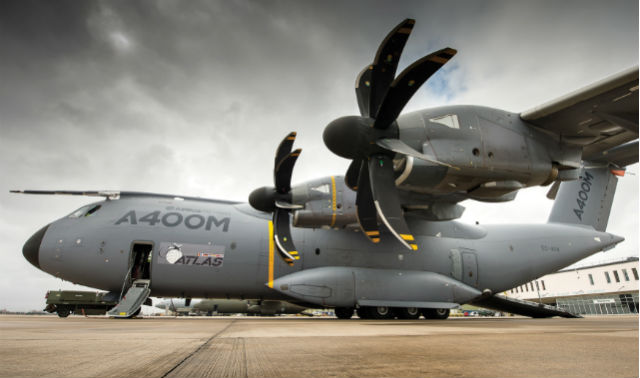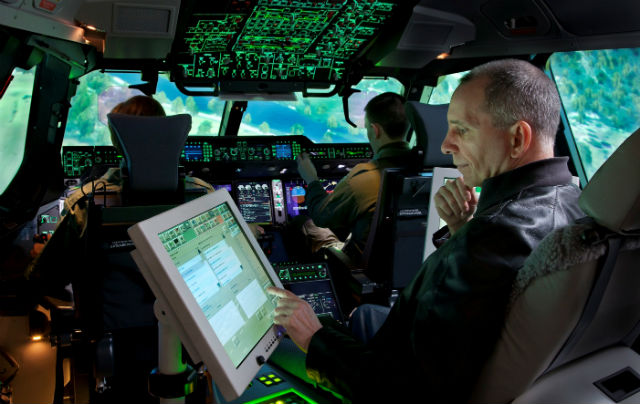The UK Royal Air Force’s first pair of Airbus A400M tactical transports are scheduled to be accepted just over two months from now, with the European type to provide a long-anticipated and much-needed replacement for its already-retired Lockheed Martin C-130Ks.
A gap has existed in the RAF’s tactical air transport inventory since the departure of its last mid-1960s-vintage Hercules in October 2013, leaving just 24 newer-generation C-130Js available. As such, the introduction of 22 of the significantly larger A400M ‘Atlas’ airlifters will deliver a transformational effect, as the service begins to transition its operations after more than a decade of combat involvement in Afghanistan. Its first examples – MSN15 and MSN16 – are currently at Airbus’s San Pablo final assembly and flight test facility near Seville, Spain.
“A400M will signal a new way of working, and a step change in technology as it takes its place alongside [the Airbus A330] Voyager and [Boeing] C-17 to provide the RAF with strategic and tactical transport capability,” says Air Marshal Simon Bollom, chief of materiel (air), in a recent article published by the UK’s Defence Equipment and Support organisation. The new type will be capable of transporting 92% of the UK’s protected fighting vehicle types, and can also move equipment such as attack and utility helicopters thanks to its usable payload capacity of 32t, plus up to 5t of installed mission equipment.

An A400M at RAF Brize Norton, Oxfordshire. The UK has 22 of the tactical transports on order, and will receive its first pair during September
Crown Copyright
For the UK, the largest military vehicle that has so far been involved in loading trials with the A400M weighed some 28t. The heaviest single load mandated for the airlifter is the German army’s Puma infantry fighting vehicle, in a 33t configuration.
With a total of four A400Ms due to be delivered this year – also counting MSN17 in October and MSN19 in December – and another eight to follow during 2015, the RAF is preparing to complete a rapid adoption of the type, which has already been fielded by the air forces of France and Turkey.
Indeed, the UK’s eagerness to introduce the new model is highlighted by the fact that its lead example was originally due to be delivered to the French air force, before the allies agreed to a production sequence swap. The RAF has previously outlined a schedule under which the new type will be declared an in-service asset during March 2015.
The A400M programme’s ninth of 174 production aircraft on order for eight nations, MSN15 will arrive at the RAF’s Brize Norton base in Oxfordshire. Preparations at the site are already in full swing, with the service’s first pilots, loadmasters, avionics technicians and maintainers already having received instruction on the type. This activity has been performed largely at Airbus’s International Training Centre (ITC), located just opposite its final assembly facility in Spain.
“They have been coming here in significant volumes,” says Ian Burrett, the company’s head of training and global support services, speaking at the ITC site in early June. According to Airbus, the centre hosted the instruction of four UK pilots, 10 loadmasters and support personnel and 13 maintainers in 2013. It will train a further 13 pilots, 12 support personnel and 62 maintainers this year, representing 20% of the 427 military personnel from France, Germany, Malaysia, Turkey and the UK who are expected to undergo instruction at the company facility in 2014.
Pilot training for the UK and Germany – which will receive its first A400M in November this year – has seen Airbus extend the use of “Grizzly” development aircraft MSN3 by several months, with the asset now due to be retired in around October. It will follow lead test aircraft MSN1, which was flown for the last time earlier this year and is now expected to become a museum exhibit.
Other RAF personnel are also receiving some instruction directly at Brize Norton, where a suite of training equipment is progressively being declared ready for use.
This process has been assisted by the early delivery of some equipment to the UK, including a four-month acceleration to the availability of a cockpit maintenance operating station and a loadmaster workstation; the latter should be ready for training during July. Previously, a classroom-based training system was delivered on schedule in July 2013, and made available to the RAF earlier than planned through the loan of supporting laptops by the A400M Training Services joint venture, established by Airbus and Thales.
The UK Ministry of Defence in March 2013 signed a £226 million ($384 million), 18-year deal with the company, which is responsible for delivering training service support contracts, as well as providing a dedicated training building – available for use from March 2014 – plus courseware, databases and some instructors.
The facility’s first of two full flight simulators will be ready to support training later this year, having entered site acceptance testing during June. A recently-ordered second simulator is scheduled for delivery in 2016. The UK’s training infrastructure will also include a cargo hold trainer, to be installed the same year, with loadmasters and other personnel currently using an operational device at the ITC near Seville.

The UK facility's first full flight simulator will be ready for use later in the year
Thales Training and Simulation
The RAF’s first ab initio students to train on the A400M will begin their instruction at Brize Norton from April 2015. Eventually to be operated by the 24 Sqn training unit and its 47 and 70 squadrons, the service’s Atlas airlifters will be supported using a new, three-bay hangar built at the site.
Significantly, MSN15 will be the first A400M to be produced to a standard beyond the initial logistics transport mark handed over so far to France and Turkey. For the RAF, this means that its first aircraft will be capable of performing initial tactical tasks, such as basic aerial delivery tasks, and also of receiving fuel in-flight. The latter process is currently being supported during flight trials in Spain, involving one of the UK’s Voyager tanker/transports.
Increased tactical capabilities will be added to the aircraft from mid-2015, to expand the early features and also introduce defensive aids system equipment for self-protection. The UK MoD last year placed an £80 million order with Northrop Grumman to provide large aircraft infrared countermeasures equipment for its Atlas fleet. Meanwhile, Airbus in March performed a full test of the type’s flare dispensers, bringing to an end what says head of A400M flight tests Eric Isorce says was a 65-flight campaign.
“The full military capability of A400M will be realised by 2017, when it reaches full operating clearance,” says Bollom. Under current plans, the RAF’s final A400M should be delivered during 2019, with earlier examples to receive capability upgrades to keep pace with new arrivals.
The UK is currently in the process of finalising a support contract with Airbus to cover its initial operations with the A400M. A longer-term support and spares mechanism is to be made in conjunction with the French defence ministry.
Once available for operational use, the RAF’s A400Ms will join nine C-17 strategic transports, a core fleet of nine Voyagers – and its C-130Js, which have been slated for early retirement during 2022.
According to Airbus, its Grizzly fleet, originally five-strong, had by early June amassed a combined total of more than 6,340 flight hours in roughly 2,280 flights, leaving around 1,000h to be amassed in order to complete core development work on the type.
With demonstrations having recently been performed in Kazakhstan and Mexico, and last year for potential future Middle East users Saudi Arabia and the United Arab Emirates, successfully bringing the A400M into service in the UK later this year will be a highly significant milestone for the programme.
Source: Flight International



















